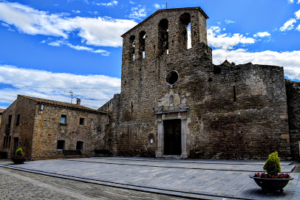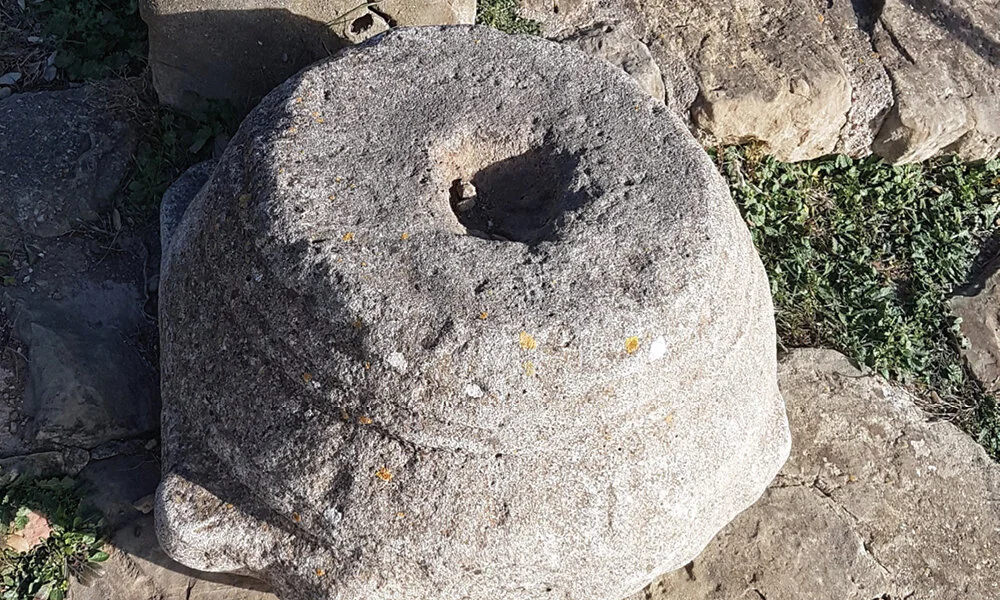 I’ve visited the ruins of Ullastret more than once. They are unique and with some imagination, mind boggling. With Covid, the museum is most likely closed, but the ruins themselves are fun to see in a very scenic spot.. I’m borrowing from the CallCarlos blog, Enjoy!
I’ve visited the ruins of Ullastret more than once. They are unique and with some imagination, mind boggling. With Covid, the museum is most likely closed, but the ruins themselves are fun to see in a very scenic spot.. I’m borrowing from the CallCarlos blog, Enjoy!
The original Iberians
We are travelling all the way to ancient times, to when Iberians populated this part of this peninsula that bears their name. The Iberians were an ancient people indigenous to the eastern part of what is today Spain, in lands that stretched from eastern Andalucia and Murcia in the southeast all the way up the Mediterranean coast, including the hinterland, to this Empordà region of Catalunya, and even beyond into parts of the Languedoc-Roussillon region of southern France. Although the Iberian Peninsula had already been inhabited by anatomically modern humans for over 40,000 years, Iberians began to develop as a culture around the 6th Century BCE. They were not a unified people but rather a collection of different tribes who shared cultural and linguistic characteristics, who traded, intermarried and sometimes fought each other. Of course, they didn’t call themselves “Iberian” either; it was the Greeks, and later the Romans, who gave the name “Iberia” to the peninsula that is today home to Spain and Portugal, and “Iberians” to its people, and the name stuck. Although the Romans often used the term “Iberian” to refer to all the peoples that lived here, in fact most of the west, centre and north of the peninsula was home to Celtic tribes, as well as Aquitanian tribes in the north whose language evolved to become the Basque language still spoken today. Linguists believe that the language spoken by the Iberians would have been related to some degree to that of the Aquitanian tribes, but it is officially listed as an “unclassified language”. Like the rest of the pre-Roman languages on the peninsula, Iberian tongues gradually disappeared as the whole peninsula become Romanised, leaving us today with languages descended from Latin: Portuguese, Castelleno, Gallego and Catalan, along with their various dialects, with only Euskera (Basque) as a reminder of pre-Roman times.

Map of the pre-Roman peoples of the Iberian Peninsula
The Empordà Iberians
Just outside today’s medieval village of Ullastret lie the ruins of an ancient settlement that was one of the largest such settlements of all the Iberian territories. In fact, it was more than a mere settlement but rather a city and, indeed, the capital of the lands ruled by the Indiketes (also spelt “Indigetes”), a confederation of four tribes that occupied lands that roughly correspond to the Province of Girona we know today: the Empordà region, plus territory further to the west and also down the coast to Lloret de Mar – basically what we today call the Costa Brava (and then some!). Sites of other Indiketae settlements are also to be found locally at Platja de Castell and La Fosca, both in Palamós. The Indiketes were the original Costa Bravans!
The Iberian way of life developed from its primitive origins to become a culture in its own right mainly due to contact with peoples of the eastern Mediterranean, specifically the Phoenicians/Carthaginians and Greeks, who travelled all over the Mediterranean and formed settlements whose purpose was trade and exchange rather than conquest. Just up the road from Ullastret, on the outskirts of L’Escala, are more ruins that we can visit today, this time of the ancient Greek settlement of Emporion (meaning “place of trade”) which had a population of about 1,000 (similar to secondary Iberian settlements in the region), and with whom the Indiketes had a friendly trading relationship.
The City of Indika
As already mentioned, the settlement at Ullastret was really more of a city in its day and the population is estimated to have been around 6,000 inhabitants. It is also believed that its Iberian name was something along the lines of “Indika” or “Undika” – Ullastret being, of course, the Catalan name for the nearby medieval town founded many centuries later. The site for their capital was strategically chosen by the Indiketes because of its commanding views over the surrounding lands – and a lake!
When we visit “Indika” today we can see lands far into the distance, but in the time of the Indiketes the same view also took in a large lake that no longer exists today. In fact the city of Indika was made up of two parts; the ruins that we can visit today and a second smaller population centre on an island in the middle of a lake that would have been about twice the size of Lake Banyoles today! Standing on the hill where the museum is now, and looking in the direction of Castell de Montgrí, we can see the flat plains where the lake once was. And speaking of the Castell de Montgrí, you may wonder why the Indiketes didn’t choose that as the site for their capital. The answer is pretty straightforward really; probably for the same reason the 13th-century castle that is still perched on top was never completed. Although its superior elevation might have offered views even farther into the distance, it also made it almost as inaccessible to potential inhabitants as to possible invaders!

Looking over plains where a lake used to be, with Castell de Montgrí in the distance
And so the city of Indika was built where we see it today, and with walls and defences that would’ve been pretty impressive for their time, and which are today the best-preserved of any Iberian settlement in all Catalunya. To the experts the influence of the nearby Greek colonies of Emporion (Empúries) and Rhode (Roses) and their trade with the eastern Mediterranean are clear to be seen in Indika and in how it was structured. The inhabitants also built a couple of temples on the site where the museum is today and, although very little is known about their worship, it is believed that the wolf was in some way sacred to the Iberians. There are examples of their writing here too but, in the absence of an Iberian equivalent of the Rosetta Stone, we are unable to translate their language to learn more.

Some of the ruins of the ancient Iberian city of Indika
Built to impress!
Being their capital, Indika was built to be symbolic and was well planned before construction. It had a well organised urban structure with main and secondary streets, and, most importantly, its city walls.

Some ruins of where houses once stood long ago in Indika
These walls were built to impress and deter other neighbouring tribes as much as to defend from any attacks from them. It must have worked as experts believe that attacks were generally quite rare and any warfare that did occur in Iberian times was only as a result of scarcity of food due to occasional poor harvests. Mostly the Iberian tribes would have traded with rather than fought each other and so the defensive walls of Indika were more than adequate in the rare event of an attack from the likes of the Illergetae, for example (see map). Adequate, that is, until a far superior force invaded their lands: the Romans!

The walls of the ancient city of Indika seen from the outside
The Romans are coming!
You remember the Phoenicians? The largely peaceful traders from the eastern Med, those nice people who introduced viticulture to this part of the world? Well, their less peaceful descendants, the Carthaginians, having lost the First Punic War against Rome, had begun to occupy the Iberian peninsula in order to try and pay their enormous war debts to the same Romans. Starting from the south they spent two years conquering Iberian and Celtic tribes and had advanced as far as the River Ebro in today’s southern Catalunya. En route they also sacked the Roman-allied city of Saguntum (just north of Valencia today), thus beginning the Second Punic War. This was the war where Hannibal famously crossed the Pyrenees and Alps with his war elephants, and it was effectively the World War of its time, involving Celtic, Iberian and Gallic tribes, amongst many others, fighting either for or against the Romans or Carthaginians, or both!

Map showing tribes and their allegiances during the Second Punic War
In this war most Iberian tribes allied themselves with, or at least were mercenaries for, the Carthaginians, as did – importantly for the Indiketes – the Illergetae who lived to the north of the Ebro and were their neighbours to the west. They began to attack Indiketae territory – and this time not because of any poor harvests! It is debated whether the Indiketes actually allied themselves with Rome as a result of these attacks or whether they were simply collateral casualties as the Romans came through their lands to engage in battle with the Carthaginians and their allies. In any case allegiance to either side would have made little difference in the long run as the end result was the same: the Roman victory in the war was the beginning of the end of the Iberian culture on the entire peninsula. In 218 BCE, the first year of the war, Indikete lands already came under Roman control. In 195 BCE they eventually rebelled against their conquerors but, predictably, were ruthlessly crushed. Even their shared worship of the wolf with the Romans wasn’t enough to save them! Undoubtedly the Romans would eventually have made their way to Iberia anyway in the course of their conquests, but the Second Punic War marked the beginning of Romanisation and assimilation of its indigenous peoples into the Roman way of life.
Visiting the ruins
This fascinating archaeological site can be visited all year round and is open every day except Mondays. From June to September it is open from 10:00 till 20:00, and the other eight months of the year from 10:00 to 18:00.
Entry is €5 per adult and €3 for over 65s. It is free for under-16s and the unemployed, and is also free for absolutely everyone on the first Sunday of every month (except in the high tourist season). There are also certain other dates when entry is free of charge (unless they happen to fall on a Monday!)
You can read more, purchase tickets and check for days when admission is free on the website, which is available in Catalan, Spanish, French and English.
There is an audio tour available which works by scanning barcodes using your smartphone at different points along the tour. The barcodes are numbered so you can follow the suggested route and most of the audio clips are between about 90 seconds and 3 minutes long. The audio tour is available in Catalan, Spanish, French and English, and gives a very easy-to-listen-to explanation as you walk around the ruins, with their streets, water and food stores, drainage system, houses and so on.

The remains of walls of Iberian houses and other buildings just outside Ullastret

Underground water storage tanks beside an ancient street


Silos used for storing grains in the ancient Iberian city near Ullastret

Views from Indika of the surrounding Baix Empordà countryside

Parts of ancient Iberian walls still standing in Indika
Because of the ongoing Covid-19 situation earphones are not currently being provided so best bring your own, but as the tour is almost all outdoors you won’t be bothering other visitors if you play the audio aloud from your phone.
The fact that the tour is mostly outdoors is actually one of the advantages during these pandemic times as the ruins are, at least for now, remaining open as normal when so many other museums and cultural sites are being forced to close.
The small museum which houses lots of artefacts from around the local area is the only indoor part of the tour. All of the text inside the museum is in Catalan only but your audio guide will explain as you continue the tour – although maybe best use your headphones in here!
Other archaeological sites
And so there you have it; a fascinating way to spend an afternoon while learning about the original inhabitants of these beautiful lands we now call home – or are just visiting!
A good website to find out about other other interesting archaeological sites in Catalunya is the Museu d’Arqueologia de Catalunya, again available in the same four languages.
Happy History!

Recent Comments